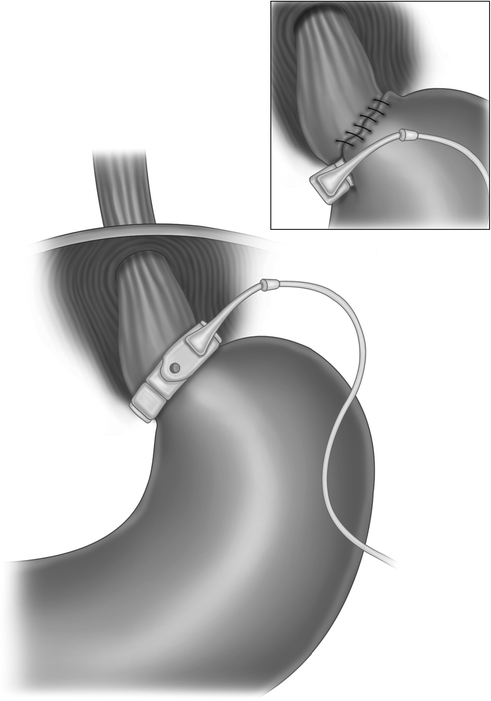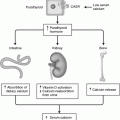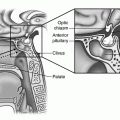Congenital
Genetic predisposition
Prader–Willi syndrome
Endocrine disorders
Cushing’s disease/syndrome
Hypothyroidism
Environmental
Hyperphagia
Sedentary lifestyle
Genetic Predisposition
In some children, genetic factors in isolation may predispose to development of obesity; such conditions include genes that regulate appetite and metabolism, which even when exposed to normal calorific intake will predispose to obesity. Rare genetic conditions should be considered in children presenting at a very young age with obesity, e.g., Prader–Willi syndrome. Studies undertaken have demonstrated that children who are born to two obese parents are at higher risk of childhood obesity compared to children born to one obese parent [3]. Others have found that higher maternal weight entering pregnancy increases risk for obesity and its cardio-metabolic complications among offspring [4].
Recent studies have also demonstrated that when clinicians classify children by BMI categories and counsel about the risk for future obesity, they should recognize that greater height may be a marker for increased risk of adult overweight and obesity [5].
Endocrinopathies
The two main endocrine abnormalities implicated in the development of childhood obesity are Cushing’s disease and hypothyroidism, although the link between obesity and the latter is weaker in children than adults.
Environmental Factors
Studies in the USA have reported an association between living in socially deprived areas and an increased incidence of childhood obesity. These results provide a new insight into the relationship between broader social and economic context and child obesity risk [6].
Previous studies suggested that breast-feeding may be protective against the development of childhood obesity. However, a recent randomized trial demonstrated that breast feeding does not reduce measures of adiposity at 6.5 years of age, and previous suggestions of protective effects against obesity may reflect confounding factors and selection bias [7]. Some studies have also demonstrated that early prenatal and postnatal growth patterns are important markers of risk of obesity later in life, with rapid neonatal weight gain a clear risk factor for obesity and metabolic syndrome in later childhood and adult life [8].
Lack of physical activity has also been implicated in causing obesity and cardio-metabolic risk in childhood. Studies undertaken have quantified these associations using objective physical activity measurements in children from different ethnic groups and demonstrated that efforts to increase activity levels in such groups would have equally beneficial effects [9]. Studies have also not surprisingly shown that limiting access to ‘fast foods’ could have beneficial effects on reducing childhood obesity [10].
Maternal depression and permissive parenting style are also potentially important risk factors in childhood obesity. It has been suggested that future research should clearly determine the correlation between these [11].
Psychological Factors
The impact of a child’s temperament and the maternal perception of a child’s BMI depend on the child’s age. For example, children with a difficult temperament and insensitive mothers have a significantly higher risk for being overweight or obese during the school age phase, but not during early childhood. This may hold significant implications for childhood obesity prevention/intervention programs in which parents can be appropriately targeted [12]. Conduct problems in childhood are associated with being overweight and obese in young adulthood. Future studies should address the potential for interventions to reduce obesity risk in young adulthood for boys who manifest conduct problems early in life [13].
Management
The complex nature and multifactorial etiology of childhood obesity make it a difficult condition to manage. Management necessitates the use of a multidisciplinary team approach, reinforced by the limited systematic reviews of childhood obesity interventions that provide some practice-relevant information [14].
For young children who have no other health concerns, the goal of treatment may be weight maintenance rather than weight loss. For an obese child, maintaining weight whilst waiting to grow taller may be as difficult as losing weight is for older people. However, for older children or for younger children who have related health concerns, weight loss strategies are recommended.
Education
As overeating and a sedentary lifestyle are the two commonest factors directly attributable to the development of obesity, advice on diet and physical activity form the basis of any treatment offered to the patient. Physical activity not only burns calories, but also helps nutritional development of the child with resulting enhancement of both physical and mental health. Indeed, it has been shown that increased physical activity in childhood helps children maintain desirable weight during teenage years, regardless of the hormonal and emotional changes that occur during this period of life. Limiting time spent watching television and reducing recreational computer usage has both been deemed beneficial in increasing activity levels. Children should be encouraged to partake in any form of physical activity and this does not necessarily mean organized sporting activities. Children’s activity levels often represent the activity levels of the parents, and as such, parents of obese children should also be encouraged to increase their activity levels.
Diet
Dietary factors play a significant role in contributing to obesity [10], with one of the largest drivers recognized as the increased consumption of sugar sweetened beverages over the past decade [15]. Parents have overall responsibility for the purchase, preparation, and location of consumption of food, and therefore play a major contributor role in prevention. Factors that may aid in weight reduction include:
adequate fruit and vegetable intake
limiting sweets and soft drinks
limiting intake of ‘fast food’
Delayed introduction of solids is associated with reduced odds of child overweight/obesity. Wider promotion of current infant feeding guidelines could have a significant impact on the rates of child overweight and obesity [16].
Psychological Input
Child and adolescent psychiatrists frequently encounter children who are obese and may be asked to work alongside primary care physicians and other specialists who treat youngsters with obesity. A multidisciplinary approach will allow optimal therapeutic recommendations for this population of patients and their families [17].
Medication
The two commonest prescriptions of weight loss drugs available for adolescents used to be sibutramine and orlistat. However, in January 2010, the Medicines and Healthcare products Regulatory Agency announced the suspension of the marketing authorisation for the obesity drug sibutramine (Reductil). This followed a review by the European Medicines Agency that concluded that the cardiovascular risks of sibutramine outweigh its benefits. Emerging evidence confirms an increased risk of nonfatal heart attacks and strokes with this medicine. Orlistat, which is approved for adolescents older than 12, prevents the absorption of fat in the intestines. Unfortunately, this can have the rather unpleasant side effect of problematic diarrhea and nutritional problems associated with fat malabsorption.
Surgery
Severe or morbid obesity, with a BMI exceeding 35–40, is often refractory to all therapies other than surgery. Bariatric or weight loss surgery is not generally recommended in childhood as it is fraught with ethical issues and the potential long-term benefits and complications of enteric diversion are not yet fully understood. On the other hand, it has been suggested that bariatric surgery in adolescents may have less complications and a shorter hospital stay than in adults [18]. The National Institute for Clinical Excellence (NICE) has outlined the exceptional circumstances that bariatric surgery is permitted in the UK:
- 1.
The child/adolescent has achieved or nearly achieved physiological maturity
- 2.
BMI ≥40 kg/m2 or 35–40 kg/m2 with other significant disease (e.g., type 2 diabetes, high blood pressure) that could be improved by weight loss
- 3.
All appropriate nonsurgical measures have failed to achieve or maintain adequate clinically beneficial weight loss for at least 6 months
- 4.
The child/adolescent is receiving or will receive intensive specialist management
- 5.
The child/adolescent is fit for anesthesia and surgery
- 6.
There is a commitment to the need for long-term follow-up.
Preoperative Assessment
The early manifestations of the comorbidities associated with obesity in adults are already present in severely obese children and should be addressed for their safe anesthetic management. Perioperative respiratory events are more frequent in overweight and obese patients [19] and therefore respiratory function should be optimized before surgery. Cardio-respiratory fitness should be optimized prior to bariatric surgery to potentially reduce postoperative complications [20]. Despite the excessive reserves of fat, obese patients are frequently nutritionally deficient related to poor dietary intake and this also poses major risks to postoperative recovery, especially in terms of wound healing.
Surgical Options
In broad terms, the options for operative management of obesity can be divided into restrictive procedures and malabsorptive procedures. These can be performed either as open or laparoscopic procedures [21], with the majority of weight loss procedures worldwide being conducted by latter approach.
The surgical intervention required depends on the eating habits of the patient. Patients who eat large volumes infrequently require restrictive procedures (gastric band/sleeve gastrectomy), whereas those who consume small amounts frequently require malabsorptive procedures (gastric bypass/duodenal switch).
Laparoscopic Gastric Band
A laparoscopic adjustable gastric band is an inflatable device that is placed around the proximal stomach to create a stoma which restricts the passage of food (Fig. 17.1). The proximal pouch rapidly fills creating a feeling of satiety and reducing the sensation of phagia.


Fig. 17.1
Gastric band
Gastric bands are particularly useful for volume eaters, i.e., large meals or bulky foods. The restriction of the gastric band can be adjusted by a small access port placed under the skin. Saline is introduced or removed via this port to tighten or loosen the band and alter the volume of food allowed to pass. As the patient loses weight, there is a loss of perigastric fat, requiring adjustment of the band.
Unlike more open forms of weight loss surgery, gastric banding does not require cutting or removal of any part of the stomach and it is also reversible. Removal can be achieved as a laparoscopic procedure, after which the stomach usually returns to its normal pre-banded state. The postoperative stay for patients undergoing a laparoscopic band is usually 24 h, which is considerably less compared to other operative interventions.
Stay updated, free articles. Join our Telegram channel

Full access? Get Clinical Tree







